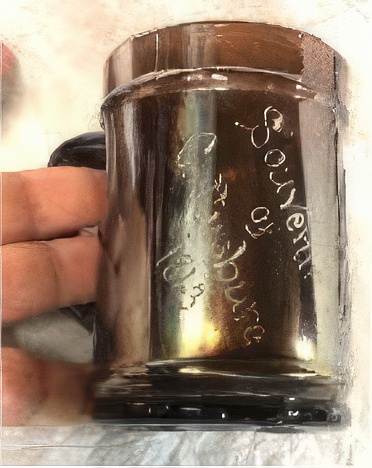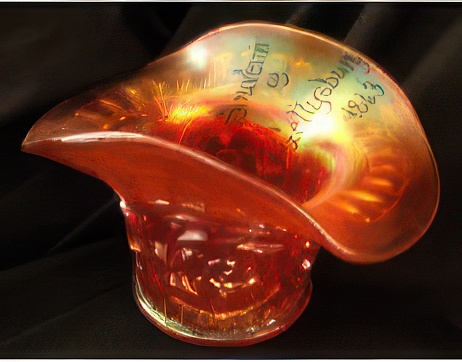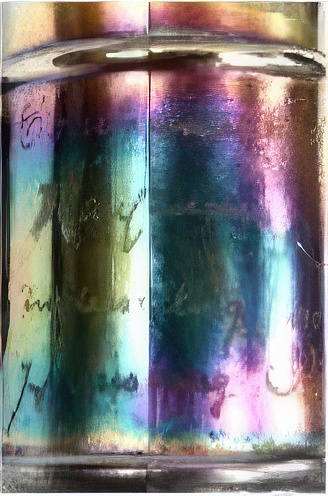Fisherman’Fisherman’s Mugs
By Dr. Larry Keig
The Fisherman’s is by far the most available of Dugan and Diamond’s fin-and-feather mugs. It, like the harder-to- hind Heron, was made in the Dugan era of the factory’s production, probably from mid1910 through early 1913*. The other bird mug, the Stork and Rushes, was made later by Diamond, likely between1916 and1920. The Fisherman’s was made mostly without souvenir inscriptions but was also sold or given away with hand-scripted or etched decorative calligraphy.**
Pattern Description and Colors
Fisherman’s and Heron mugs are both four inches tall. Their top and base diameters are nearly identical at two and one-half inches. In size and shape, the two are virtually alike.

Almost all the patterning is on the front side, handle right. The fish, maybe a carp or perhaps instead a trout, a bass, or just a generic variety. Appears to be in a stream or river. Also in the forefront, below the fish, is a good-sized water lily. Flanking the fish and flower are rangy plants. These may be bull rushes, a plant native to bodies of water. The plants are, not surprisingly, similar to those on the Heron mug as these and the animal life on the two mugs are aquatic.
Above and below the design elements, all the way around the circumference, are plain bands. The banding is the only patterning on the back side.
Five colors are known. The amethyst are easily obtainable. These come in shades ranging from lavender through amethyst and purple to the nearly opaque black amethyst, oxblood, and fiery amethyst. The next most available, the marigold, are not all that tough to find, either. The peach opal are more difficult to find.
The cobalt and marigold over vaseline are rare with hardly any having been reported. The HoC database lists but two cobalt blue and two marigold over vaseline as having changed hands from its inception through May 2022. Dave Doty reported three of the blue as having sold in the first decade of the new millennium.
Lettered Souvenirs
The amethyst/purple and marigold Fisherman’s mugs are among the most popular pieces inscribed with non-molded souvenir lettering. They also appear to be scripted with a wider array of lettering types than any other Dugan or Diamond pattern or shape. These include enameled hand-lettering and etching. Another has a paper label attached to the underside of the base in which the establishment which sold or gave it away is identified.

The two photos above have the enameled hand-lettered scripts – Souvenir of Fairfield, Iowa and Souvenir of Loretta, Minn.
The Enameled Hand Lettered. The largest number of Dugan’s are those with hand-written names of villages, small and medium-size towns, and cities inscribed on the non-patterned side or the area between the plain band near the top and rim. A representative sample includes those for Fairfield, Iowa, which in 19103 had a population of less than 600. Another was for the village of Mederville, Iowa, population of less than 200. Others were made to be distributed in and around Lorretta, Minnesota (population just over 150) and Princeton, Wisconsin (population just under 1300).

The amethyst/purple Fisherman’s mugs with Gettysburg lettering are the most intriguing. They are dated 1863, long before carnival was made. It is likely they were manufactured and decorated in 1913 to commemorate the fiftieth anniversary of the Civil War battle fought there.
How these historically significant pieces were distributed remains a mystery, for Gettysburg’s population was just 63 in 1910. One has to wonder if an enterprising vendor commissioned the glass and then set up a tent and table on the grounds to hawk it during the week-long Great Reunion of 1913. That event brought together more than 50,000 visitors: aging Union and Confederate soldiers, their families and friends, and countless others.****

Sidebar. Gettysburg carnival souvenirs were not limited to Fisherman’s mugs, as Neal Becker has pointed out. They are also available in marigold Circle Scroll hats and may also exist in other patterns and colors.



The Asbury Park, 1910, above, is an etched pattern.
The Etched. A few of the souvenirs have etched lettering. These include those with the names of hamlets, towns, and cities. One is for Harrisburg, Pennsylvania (population nearly 12,000). They also include those bearing the names of recipients. Two of the new owners were “Sarah 1910” and “Thomas 1910.” The lettering on these was probably placed there at the site of sale, perhaps by a jeweler who would have had easy access to etching chemicals and implements. It is unlikely it was done at the glassmaking factory.

The Labeled. The Amazon Hotel and Café in Bridgeport, Connecticut population just shy of 4,000), used Fisherman’s mugs to advertise or for souvenirs. A round printed paper label was attached to the base of the mug. Most of the labels were undoubtedly removed at some point in time or wore off with washing, but at least one has survived intact.
One final thought. What do you suppose the likelihood is that the Dugans, in a sly or mischievous way, produced far more Fisherman’s than Heron mugs in order to provide fresh flesh for the rapacious raptors?
Notes
*It is easy to determine the dates of manufacture for the Fisherman’s mug. In one case, the date is inscribed on a souvenir in the pattern. On another, the production date is alluded to by the date placed on it
**I make no distinction between lettered souvenirs with molded lettering and lettering applied in other ways. It should be noted that this is different from distinctions made on sites curated by Dave Doty and the HoC team.
***The population counts cited are from the 1910 census. That’s the census date closest to the dates of production and distribution of the lettered pieces.
****The headliner for the July 4 culminating event was President Woodrow Wilson. In a conciliatory and unifying address, he said, in part: “We have found one another again as brothers and comrades in arms, enemies no longer, generous friends rather, our battles long past, the quarrel forgotten—except that we shall not forget the splendid valor.”
Photos courtesy of the auctioneers, HOC, and the editor.
This article first appeared in the ICGA Pump in the September 2022 issue and is reprinted with permission.
